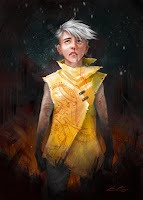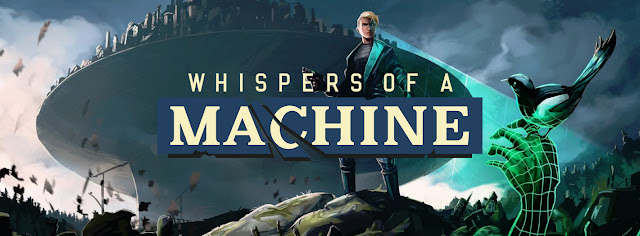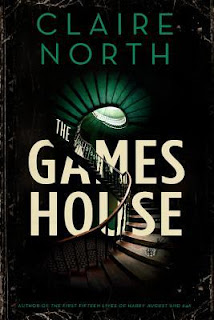One day, I hope to discover a speculative fiction magazine called "Fluffy and Lovely Futures", which will be full of all the diverse ways in which people can just be fundamentally OK. When I have this magazine, (and if somebody is already out there publishing it, please point me in their direction!) I'll save up the issues to read right after particularly heartbreaking issues of other magazines. The only issue is that Fluffy and Lovely Futures might have to come out on a weekly schedule to keep up with the many and varied ways in which the stories in other magazines keep breaking my fragile little heart. To be fair, they do it so well that I can't help but come back for more...
What do I have for you this June? Read on and find out:
Fireside Fiction Issues 66-68 (Read Online)
I'm sad to see that Julia Rios will soon be leaving her editorial position at Fireside, but excited to see them test a new editorial model: each quarterly issue of Fireside will go to a different editor, and the plan is to bring in not just established names but also new editorial voices. It sounds like a great way to shake up the magazine's diverse offerings still further and to offer opportunities to a wider range of editors, and I'll be really intrigued to see what changes it brings to Fireside's overall tone. Here in the present, this quarter's offerings are another weird and wonderful, emotionally driven mix of flash fiction and short stories. "
My Sister is a House" by Zoe Medieros proposes a world where kids can grow up to be almost anything - animate or otherwise - but that those things are defined in aptitude tests and there's an ongoing cultural argument over whether it is possible to change one's nature. The narrator's and her twin sister have always felt there is a gulf between them across which it is hard to communicate, and when her becomes a house, the narrator moves into it and speculates on how this changes the way she can connect with her sibling. The premise allows for musings on family bonds and human nature which defy easy categorisation but come together well in the context of the story, creating something weird and thought provoking and full of beautiful asides.
"
How to Say I Love You With Wikipedia" by Beth Goder is a story about a Mars rover trying to communicate its "feels" with its human companions during a manned science mission; I'm personally a bit over anthropomorphising the tragedy of dead Mars rovers after the outpouring from Opportunity a few months ago, but it's a sweetly told story that will no doubt appeal to those being less cynical about its central premise. I mean, for all my grumpiness, one fundamentally can't go wrong with a robot pal, right? For me, the standout story from the quarter comes in April with "
Aging Elements" by Ben Francisco, which takes the Icarus and Daedalus myth and turns the lesson into something very different; in this version, Icarus is not brought down by his hubris and by failing to listen to his elders, but takes his own knowledge and uses it to literally surpasses his father, leaving him heartbroken but hopeful for his son's future even as the people around him take the incomplete story he has told and turn it into an overly simple lesson which doesn't reflect their truth. It's got all the elements that makes a retelling worthwhile, providing a fresh take both at the surface and in the deeper layers of the story, and the emotional elements are deeply affecting.
Rating 7/10
Anathema Magazine Issue 7 (Read Online)
Anathema is back for a bigger, better seventh issue, including some really neat story and poetry thematic match-ups (the poetry is new and it works great!) While I don't normally review the non-fiction of magazines, the
editorial essay of this issue also really spoke to me: it's about how we as readers can support and boost the range of fiction that we want to see out in the world, and definitely worth a read for anyone reflecting on that.
The stories themselves are more hit and miss for me than in previous issues - specifically, the story about arranged "mating" and alphas and betas hits too many personal "nopes" - the stuff that hit the spot lives up to the challenging, heartbreaking excellence I've come to expect from the publication. "
Raices (Roots)" by Joe Ponce is the standout here for me, drawing on the xenophobia and abuse of the USA's current border regime - including the separation of children from their parents - to tell the story of a man from the USA whose Mexican half-sister and her son cross without documentation to stay with him, against the backdrop of an epidemic where migrant children appear to be developing plantlike symptoms. That premise plus the title should probably clue you in to where this is going; it does so in a way which juxtaposes the body horror of peeling skin and creaking movements with the mundane awfulness of a racist, hostile immigration regime, questioning bonds of family, nationality and of human empathy in a way which is chillingly recognisable in the way countries like the USA (and UK) treat those who come across their borders. The issue's first story, "
Moses" by L.D. Lewis, also explores supernatural power and trauma from a different angle, looking at the life of a woman with the power to make people around her disappear, and the impact that this has on her as she seeks ways to control herself and avoid harming those she loves, no matter how self-destructive the methods might be.
Rating 7/10
The Dark, May and June 2019 (Read Online)
Inspired by my horror reading of a couple of months ago, I've added another subscription to my expanding list in The Dark, a monthly horror magazine releasing two new and two reprinted stories every month. The new stories and the reprints are mixed in here, and they're all great in that awful, awful way where really everything is not OK at all and we're all going to die horribly. Yay!
May starts off with "
Wildling", by Angela Slatter: a story about eating cats (among other things). LP is a childless woman whose home is visited by a "Wildling" who kills and eats her boyfriend's unpleasant cat. Ground down by a society which keeps assuming her worth is only proportionate to her childlessness, she develops a fantasy of "taming" the child and taking it in, sourcing more cat food to try and entice them. It's a grim story whose character motivations are pretty hard to sympathise with, but the twist is perfect and awful. The second original story is "
The Wiley", a woman involved in a huge technology sales deal finds herself dealing with an unexpected consequence of the programme she helped to build, which is now affecting the world in dramatic and unexpected ways; aided by supernatural forces in her own home, she makes it her mission to figure out how to overcome the problems she has unleashed on the world in a story that satisfyingly blends magic and technology in a way which underscores the narrator's emotional journey.
June brings the terrifying, atmospheric "
Therein Lies a Soul" by Osahon Iye-Iyamu, a story which, like its protagonist, comes into the world "sticky and belting out the highest notes"; it's full of spiders and cobwebs and sickness and oppressive systems and a ghost who can steal voices, and it will make you ask "what on earth just happened" in the best possible way. "
We Sang You As Ours" by Nibedita Sen is more straightforward, but just as full of claustrophobia and inescapable destinies: Cadence, the oldest daughter of a monstrous race whose women use siren-like powers to lure humans out to sea and feed them to the ocean-faring males they are attached to, questions the life she's been brought into, especially after one of the "Mothers" who raised her runs away to apparently escape her biological calling. By "humanising" Cadence and her struggle at the same time as it shows her going through the motions of her terrifying calling, showing the way that she connects with her victim - a teenage boy whose fate the story doesn't sugarcoat with any "maybe he's a monster too" speculation - makes for a really effective, satisfying story. If you're up for some delicious discomfort, The Dark is definitely a magazine to check out, and I can't wait to see what it brings next.
Rating: 8/10
Uncanny Magazine Issue 28 (read online)
There's also plenty of creepy delights in this issue of Uncanny. Ellen Klages "
Nice Things" has the protagonist going through her unpleasant mother's things after her death, eventually baking a cathartic cake for a personal ritual that ends up not quite going to plan; Emma Osborne's "
A Salt and Sterling Sea" talks about a grieving mother rediscovering love after the transformation and death of her son; and the reprint, "
Corpse Soldier" by Kameron Hurley (originally released on Patreon) is a return to her world of body-jumping mercenaries previously explored in "Elephants and Corpses" and other stories (more on those next month, probably). The creepiness reaches a peak in Elizabeth Bear's story, "
Lest We Forget", which is told from the perspective of a war criminal who is now narrating the story of their own death. As the narrator recounts the circumstances that have led to their dying, a picture emerges of an individual and society going to great lengths to repair the horrors of war, with results that wind up creating new horror instead. It's almost a shame that the Hurley story in this issue isn't one from her Red Secretary universe, as the sense of inescapability in this story is reminiscent of the premise of that world (more on that next month). It's short, but you'll need to schedule in a few minutes to mutter "oh no oh no" repeatedly to yourself after reading.
Balancing out the creepiness, there's also a new exploration of love and family and disaspora identity, "
Probabilitea", from John Chu. Katie's dad is "a physical manifestation of Order and Chaos", as is she; meaning she's inherited his power to understand and manipulate probabilities and the fabric of reality. This is understandably a pretty terrifying power to have if one doesn't know how to control it, and Katie is working on learning how, when a friend, Jackson - who happens to be a physical manifestation of Life and Death - asks her for help with a mission that only she can complete. The character relationships between Katie and her father, and Katie and Jackson, are all highly compelling, and it's a great exploration of maintaining human relationships and respecting the self-determination of loved ones even with those godlike superpowers in the equation.
Rating: 7/10
Stories of your Life and Others by Ted Chiang
Yes, yes, Ted Chiang has a new short story collection out this year, but I have never promised you current coverage in this column and, up until now, Chiang's highly accoladed debut collection has been a notable gap in my reading. The universe decided to remind me of this fact last year when I received the collection in not one but two different Secret Santa exchanges, and I finally paid attention and got down to it (with the exception of the titular story, which I
had read and decided to skip this time around - so this review is technically just of "Stories of Others").
Having so much uncanny, slipstream-type fiction in this month's selection made it all the more interesting to sit down with Chiang's matter of fact science fictional style, and it's clear that so much of what makes this collection so well regarded is his ability to take simple yet outlandish science fictional premises and put them in a context that makes you go "oh, yes, of course". From the literal exploration of the biblical heavens - and the communities which would spring up in a centuries-long process of reaching them - in "Tower of Babylon" to the documentary narrative of a university wondering whether to make "attraction-blindness" technology compulsory in "Liking What You See: A Documentary", there's a sense of reading narratives where each piece is a controlled, explicable part of the wider whole. The common theme throughout is that of discovery: each story takes either a science fictional premise or alternate historic versions of science and the organisation of the universe, then puts characters into a position to make new discoveries within them. Different stories start this journey at different points: "Tower of Babylon" and "Understand", for example, put their protagonists at the start of a journey and follow them through it, whereas "Divide by Zero" and "The Evolution of Human Science" (a flash fiction piece originally written for Nature and by far the shortest story in the collection) focus more explicitly on the psychological repercussions of discoveries which upend one's worldview. The result is a really satisfying set of "what-ifs" from an author who, as has been consistently remarked, always seems to be at the top of his game. It's nice to read a book that lives up to the hype and, who knows? Maybe I'll get to Exhalation before the year is out.
Rating: 8/10
POSTED BY: Adri is a semi-aquatic migratory mammal most often found in the UK. She has many opinions about SFF books, and is also partial to gaming, baking, interacting with dogs, and Asian-style karaoke. Find her on Twitter at @adrijjy.















































